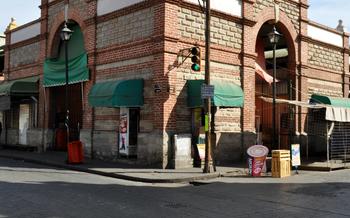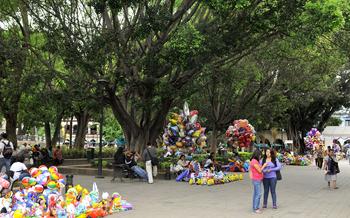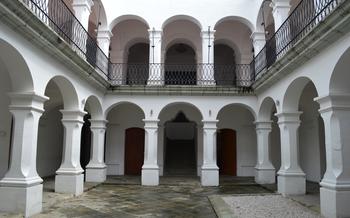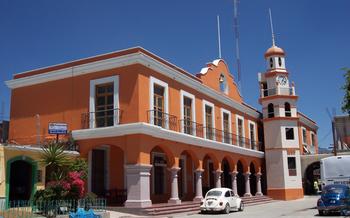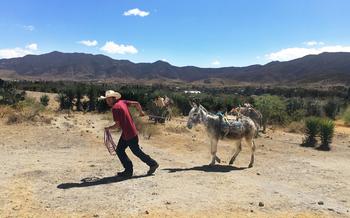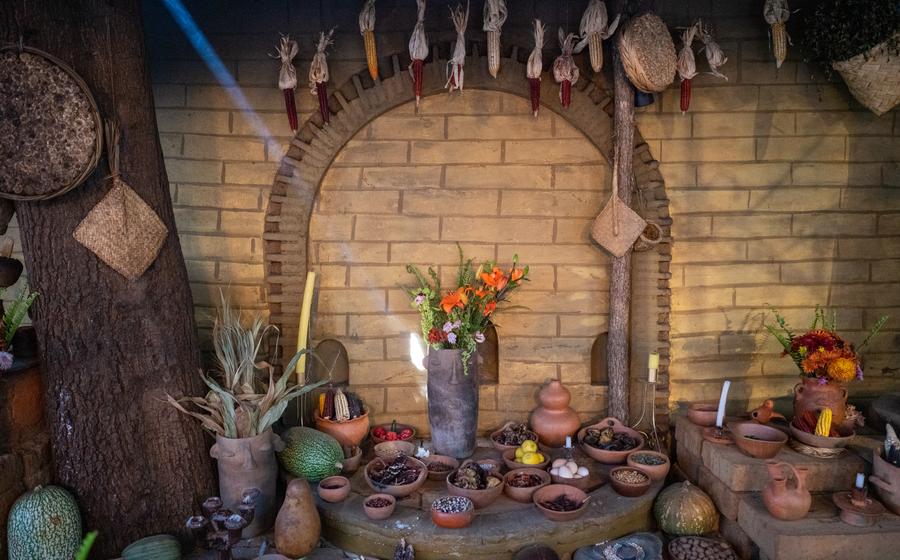
San Antonio Arrazola (Alebrijes Village)
- Evolution of the Craft Over Time
- The Alebrijes
- Visiting San Antonio Arrazola
- The Alebrijes Museum
- The Alebrijes Festival
- Meeting the Artisans
- Things to Do in San Antonio Arrazola: Exploring Beyond the Workshops and Market
- Photography Tips
- Cultural Significance of the Alebrijes
- Sustainability and Environmental Impact
- Volunteering and Workshops
- Insider Tip: Uncovering Hidden Gems and Unique Experiences
Evolution of the Craft Over Time
The craft of making alebrijes in San Antonio Arrazola has a rich history that dates back to the early 20th century. It is believed to have originated with Manuel Jimenez, a local artisan who had a vivid dream of fantastical creatures made of wood. Upon waking, he began to carve these creatures, and his work quickly gained popularity among the villagers. Over time, other artisans in San Antonio Arrazola began to create their own alebrijes, and the craft has since become a defining characteristic of the village.
In the early days, alebrijes were made using simple tools and techniques. Artisans would carve the figures from wood, using machetes and other basic tools. The figures were then painted with natural dyes, which were made from plants and minerals found in the surrounding area.
As the craft of making alebrijes evolved, so too did the materials and techniques used. Artisans began to experiment with different types of wood, such as copal and cedar, and they also began to use acrylic paints, which allowed for a wider range of colors and designs. Today, alebrijes are made using a variety of materials and techniques, and each artisan has their own unique style.
The Alebrijes
The Alebrijes are fantastical and colorful creatures that have become a symbol of Mexican folklore and craftsmanship. They are typically made of papier-mâché or wood, and are often painted in vibrant colors and intricate patterns. The Alebrijes are said to represent the spirit of the forest, and are often used to decorate homes and businesses.
The Alebrijes originated in the village of San Antonio Arrazola, in the Oaxaca region of Mexico. The craft was started by a man named Pedro Linares in the 1930s, who claimed to have seen the Alebrijes in a dream. Linares began to create these fantastical creatures out of papier-mâché, and soon other villagers began to follow suit.
Today, the Alebrijes are made by a variety of artisans in San Antonio Arrazola and other villages in the Oaxaca region. The traditional materials and techniques used to create the Alebrijes have remained largely unchanged over the years, and each Alebrije is a unique work of art.
The Alebrijes are often depicted as animals, such as jaguars, eagles, and owls, but they can also be humanoids, mythical creatures, or even abstract forms. The Alebrijes are often decorated with intricate patterns and symbols, which are said to represent different aspects of Mexican culture and mythology.
Visiting San Antonio Arrazola
Best time to visit
The best which takes place annually in July. During this vibrant festival, the village comes alive with music, dance, and colorful processions, and artisans showcase their latest creations. The atmosphere is electric, and it's a fantastic opportunity to experience the village's unique culture and traditions.
If you can't make it during the festival, aim to visit during the dry season, which runs from November to April. The weather is pleasant and sunny during this time, making it ideal for exploring the village and its surroundings.
How to get to the village
San Antonio Arrazola is located about 25 kilometers (15 miles) south of Oaxaca City. To get there, you can take a bus from the Central de Autobuses (Oaxaca City's main bus station). The buses depart regularly throughout the day, and the journey takes about 45 minutes. Once you arrive in San Antonio Arrazola, you can walk to the village center or take a taxi.
Where to stay and eat in the village
There are a few guesthouses and hotels in San Antonio Arrazola, ranging from budget-friendly options to more luxurious accommodations. For a truly immersive experience, consider staying in one of the family-run guesthouses, where you'll have the chance to interact with the local artisans and learn more about their craft.
For food, there are several traditional Mexican restaurants in the village where you can sample delicious regional dishes such as mole negro, tlayudas, and memelas. Be sure to try the local mezcal, a distilled spirit made from agave, which is a specialty of the Oaxaca region.
The Alebrijes Museum
Occupying a prominent place in the heart of San Antonio Arrazola, the Alebrijes Museum stands as a testament to the cultural significance and artistic prowess of the village's artisans. With a modest admission fee, visitors are granted access to a treasure trove of exhibits and displays that delve into the history, symbolism, and craftsmanship of the Alebrijes.
Upon entering the museum, one is greeted by a mesmerizing array of Alebrijes in various sizes and forms, each intricately crafted and bursting with color. The exhibits provide detailed explanations of the techniques and materials used by the artisans, shedding light on the creative process behind these fantastical creatures.
The museum also houses a permanent display that traces the evolution of the Alebrijes craft, from its humble origins to its current status as an internationally recognized art form. Interactive displays and multimedia presentations engage visitors, allowing them to immerse themselves in the rich cultural heritage of the Alebrijes and the village of San Antonio Arrazola.
The museum's significance extends beyond its educational value. It serves as a vital platform for promoting the work of local artisans and preserving the traditional art form for future generations. By showcasing the Alebrijes and the stories behind their creation, the museum fosters a deeper appreciation for the skill and artistry of the Alebrijes makers.
The Alebrijes Festival
Every year, the village of San Antonio Arrazola comes alive during the renowned Alebrijes Festival. This vibrant event, typically held in July or August, celebrates the rich tradition of Alebrijes making and showcases the extraordinary craftsmanship of the local artisans.
For several days, the village transforms into a bustling hub of creativity, music and cultural exchange. Visitors from all corners of the world flock to witness the mesmerizing parade of Alebrijes, where these fantastical creatures come to life and dance through the streets. The parade is a spectacle of color, movement and imagination, leaving spectators in awe.
In addition to the parade, the festival features a variety of exhibitions, workshops and demonstrations that provide a deeper insight into the art of Alebrijes making. Visitors can witness the artisans at work, learn about the techniques and materials used, and even try their hand at creating their own Alebrijes.
The Alebrijes Festival is not only a celebration of art and craftsmanship but also a testament to the cultural heritage of San Antonio Arrazola. It is a time for the community to come together, share their traditions and celebrate the magic of the Alebrijes.
Meeting the Artisans
One of the most rewarding aspects of visiting San Antonio Arrazola is the opportunity to interact with the Alebrijes makers themselves. These talented artisans are passionate about their craft and eager to share their knowledge and inspiration with visitors.
Take the time to visit their workshops, where you can watch them work and learn about their unique techniques. Ask them about their creative process, the materials they use, and the symbolism behind their Alebrijes. Many artisans are also happy to demonstrate their skills and even offer hands-on experiences, allowing you to try your hand at creating your own Alebrijes.
By interacting with the artisans, you'll gain a deeper appreciation for the artistry and craftsmanship that goes into each Alebrijes. You'll also contribute to the preservation of this important cultural tradition and support the local community.
Here are some tips for meeting the artisans in San Antonio Arrazola:
- Be respectful of their time and work. Don't interrupt them while they're working, and ask permission before taking photos or videos.
- Show genuine interest in their craft. Ask questions and engage in conversation.
- Be open to learning and trying new things. If they offer to teach you how to make an Alebrijes, don't be afraid to give it a try.
- Purchase an Alebrijes directly from the artisan. This is a great way to support their work and take home a unique souvenir.
Things to Do in San Antonio Arrazola: Exploring Beyond the Workshops and Market
While visiting the Alebrijes workshops and market is a must, San Antonio Arrazola offers a wealth of other activities to immerse yourself in the local culture and traditions. Stroll through the village's charming streets, admiring the colorful murals adorning the walls and taking in the vibrant atmosphere. Interact with the friendly locals, who are always eager to share stories about their village and its unique craft.
For a deeper cultural experience, visit the local church, Iglesia de San Antonio de Padua, which showcases stunning colonial architecture and intricate religious artwork. Take a cooking class to learn how to prepare traditional Oaxacan dishes using fresh, local ingredients. Embark on a guided hike in the surrounding mountains, discovering hidden waterfalls and breathtaking views of the valley.
San Antonio Arrazola is also an excellent base for exploring the surrounding region. Visit the nearby town of Ocotlán de Morelos, renowned for its black pottery, or venture further to the city of Oaxaca, a UNESCO World Heritage Site brimming with cultural attractions, culinary delights, and vibrant markets.
Remember to respect the local customs and traditions during your visit. Ask permission before photographing people or their homes, and be mindful of noise levels, especially in the early morning and late evening. Embrace the opportunity to engage with the locals, learn about their way of life, and support the community by purchasing their handcrafted Alebrijes and other local products.
Photography Tips
Capturing the essence and beauty of the Alebrijes through photography requires careful consideration of lighting, angles, and composition. For the best results, visit the workshops or market during the golden hours, when the natural light is soft and warm. This will help enhance the colors and textures of the Alebrijes, making them stand out against the background.
Experiment with different angles and perspectives to showcase the unique details and intricate craftsmanship of each piece. Get up close to capture the fine details of the paintwork and carvings, or step back to take in the entire sculpture. Don't be afraid to get creative and try unusual angles, such as shooting from below or above, to add depth and interest to your photographs.
To create a sense of scale and context, include elements of the surroundings in your shots. This could be the artisan's workshop, the vibrant colors of the market, or the lush landscapes of the surrounding countryside. By incorporating the environment, you'll provide a sense of place and help tell the story of the Alebrijes within their cultural context.
Cultural Significance of the Alebrijes
Alebrijes are not just decorative pieces; they carry deep cultural significance, embodying Mexican folklore and mythology. These fantastical creatures draw inspiration from pre-Hispanic legends, ancient deities, and the rich tapestry of Mexican traditions. Each Alebrije is a unique representation of the artist's imagination, reflecting their personal connection to their cultural heritage.
The vibrant colors and intricate designs of the Alebrijes are a testament to the creativity and imagination of the Mexican people. These fantastical creatures serve as a reminder of the importance of preserving and celebrating cultural diversity. By supporting the Alebrijes artisans, visitors not only take home a unique piece of art but also contribute to the preservation of Mexican cultural heritage.
The Alebrijes are a symbol of resilience and the power of human imagination to transform adversity into art. They represent the ability of the Mexican people to find joy and beauty even in the face of challenges. By embracing the Alebrijes, visitors can gain a deeper appreciation for the cultural richness and diversity of Mexico.
Sustainability and Environmental Impact
The Alebrijes artisans of San Antonio Arrazola are conscious of the environmental impact of their craft and are taking steps to minimize it. They use sustainable materials such as recycled paper and natural dyes, and they avoid the use of harmful chemicals. They also work to reduce waste by reusing and repurposing materials whenever possible.
In addition, the artisans are promoting responsible tourism in the village. They encourage visitors to stay in locally-owned guesthouses and eat at local restaurants, and they support community-based projects that benefit the environment and the local culture.
By embracing sustainability, the Alebrijes artisans are helping to preserve their craft and their community for future generations. Visitors to San Antonio Arrazola can support their efforts by buying their Alebrijes from local artisans, staying in locally-owned guesthouses, and eating at local restaurants.
Volunteering and Workshops
Volunteering and Workshops
There are several ways to get involved in the alebrijes community and make a meaningful contribution during your visit to San Antonio Arrazola. If you have a deeper interest in the craft and want to immerse yourself in the process, consider volunteering your time at one of the workshops. This is an incredible opportunity to learn directly from the artisans, assist them with their work, and gain hands-on experience in creating your own alebrije. Workshops are typically open to visitors of all skill levels, and the artisans are happy to guide you through the process, from selecting the wood to carving, painting, and finishing your creation.
Additionally, you can participate in alebrijes-making workshops offered by various organizations in the village. These workshops are designed for tourists and provide a structured learning environment where you can create your alebrije under the guidance of experienced instructors. Workshops typically last for a few hours and include all the necessary materials and tools. Participating in a workshop is a fun and rewarding experience, allowing you to take home a unique souvenir and contribute to the preservation of this traditional craft.
Remember that volunteering or participating in workshops is not only a way to learn about the craft but also a way to directly support the local economy and empower the artisans. By engaging with the community and contributing your time or skills, you are helping to ensure the continuation of this remarkable tradition for generations to come.
Insider Tip: Uncovering Hidden Gems and Unique Experiences
Beyond the bustling workshops and vibrant market, San Antonio Arrazola conceals a few hidden gems waiting to be discovered. One such spot is the El Taller de Alebrijes, a small, family-run workshop tucked away on a quiet side street. Here, visitors can witness the intricate process of Alebrijes making firsthand and engage in lively conversations with the artisans.
For a truly immersive experience, consider participating in an Alebrijes-making workshop. Several workshops in the village offer hands-on classes, allowing visitors to create their own Alebrijes under the guidance of skilled artisans. This is an excellent opportunity to learn about the traditional techniques and express your creativity while contributing to the preservation of this ancient craft.
To make the most of your visit, immerse yourself in the local culture by savoring the flavors of Oaxacan cuisine. Sample traditional dishes like tlayudas, memelas, and enfrijoladas at local eateries or indulge in street food delicacies from the village market.
As you explore San Antonio Arrazola, remember to engage with the friendly locals. They are the heart and soul of this vibrant community and are always eager to share stories, traditions, and insights into their way of life. Embrace the opportunity to connect with them and gain a deeper understanding of the village's rich cultural heritage.


